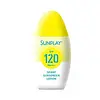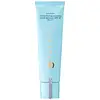What's inside
What's inside
 Key Ingredients
Key Ingredients

 Benefits
Benefits

 Concerns
Concerns

 Ingredients Side-by-side
Ingredients Side-by-side

Water
Skin ConditioningCyclopentasiloxane
EmollientZinc Oxide
Cosmetic ColorantTriethoxycaprylylsilane
Ethylhexyl Methoxycinnamate
UV AbsorberDimethicone
EmollientIsononyl Isononanoate
EmollientAlcohol
AntimicrobialTriethylhexanoin
MaskingTitanium Dioxide
Cosmetic ColorantSilica
AbrasiveEthylhexyl Salicylate
UV AbsorberPolymethylsilsesquioxane
Butylene Glycol
HumectantDiethylamino Hydroxybenzoyl Hexyl Benzoate
UV FilterCetyl PEG/PPG-10/1 Dimethicone
EmulsifyingTrimethylsiloxysilicate
EmollientPolysilicone-15
UV FilterPEG-10 Dimethicone
Skin ConditioningEthylhexyl Triazone
UV AbsorberPolyhydroxystearic Acid
EmulsifyingBis-Ethylhexyloxyphenol Methoxyphenyl Triazine
Skin ConditioningMethylparaben
PreservativeTocopheryl Acetate
AntioxidantAloe Barbadensis Leaf Juice
Skin ConditioningPropylene Glycol
HumectantDisodium EDTA
Caprylic/Capric Triglyceride
MaskingLaminaria Ochroleuca Extract
Skin ConditioningEctoin
Skin ConditioningSodium Hyaluronate
HumectantWater, Cyclopentasiloxane, Zinc Oxide, Triethoxycaprylylsilane, Ethylhexyl Methoxycinnamate, Dimethicone, Isononyl Isononanoate, Alcohol, Triethylhexanoin, Titanium Dioxide, Silica, Ethylhexyl Salicylate, Polymethylsilsesquioxane, Butylene Glycol, Diethylamino Hydroxybenzoyl Hexyl Benzoate, Cetyl PEG/PPG-10/1 Dimethicone, Trimethylsiloxysilicate, Polysilicone-15, PEG-10 Dimethicone, Ethylhexyl Triazone, Polyhydroxystearic Acid, Bis-Ethylhexyloxyphenol Methoxyphenyl Triazine, Methylparaben, Tocopheryl Acetate, Aloe Barbadensis Leaf Juice, Propylene Glycol, Disodium EDTA, Caprylic/Capric Triglyceride, Laminaria Ochroleuca Extract, Ectoin, Sodium Hyaluronate
Zinc Oxide 15%
Cosmetic ColorantEthylhexyl Salicylate 5%
UV AbsorberWater
Skin ConditioningIsododecane
EmollientCyclopentasiloxane
EmollientPropanediol
SolventHdi/Trimethylol Hexyllactone Crosspolymer
Glycerin
HumectantDimethicone
EmollientOctyldodecyl Neopentanoate
EmollientBehenyl Alcohol
EmollientDimethicone/Vinyl Dimethicone Crosspolymer
Skin ConditioningRosa Multiflora Fruit Extract
MaskingEriobotrya Japonica Leaf Extract
Skin ConditioningStearyl Glycyrrhetinate
Skin ConditioningGlycyrrhiza Inflata Root Extract
Skin ConditioningCamellia Sinensis Leaf Extract
AntimicrobialPistacia Lentiscus Gum
MaskingSericin
Skin ConditioningAlgae Extract
EmollientLecithin
EmollientInositol
HumectantPolyhydroxystearic Acid
EmulsifyingSorbitan Tristearate
EmulsifyingSodium Dilauramidoglutamide Lysine
HumectantSilica
AbrasivePotassium Sorbate
PreservativeBeheneth-20
EmulsifyingSodium Acrylate/Acryloyldimethyltaurate/Dimethylacrylamide Crosspolymer
Emulsion StabilisingPolymethylsilsesquioxane
Methicone
EmollientTrimethylsiloxysilicate
EmollientDimethiconol
EmollientDisodium EDTA
Parfum
MaskingEthylhexylglycerin
Skin ConditioningAlcohol
AntimicrobialPhenoxyethanol
PreservativeCI 77491
Cosmetic ColorantCI 77891
Cosmetic ColorantMica
Cosmetic ColorantZinc Oxide 15%, Ethylhexyl Salicylate 5%, Water, Isododecane, Cyclopentasiloxane, Propanediol, Hdi/Trimethylol Hexyllactone Crosspolymer, Glycerin, Dimethicone, Octyldodecyl Neopentanoate, Behenyl Alcohol, Dimethicone/Vinyl Dimethicone Crosspolymer, Rosa Multiflora Fruit Extract, Eriobotrya Japonica Leaf Extract, Stearyl Glycyrrhetinate, Glycyrrhiza Inflata Root Extract, Camellia Sinensis Leaf Extract, Pistacia Lentiscus Gum, Sericin, Algae Extract, Lecithin, Inositol, Polyhydroxystearic Acid, Sorbitan Tristearate, Sodium Dilauramidoglutamide Lysine, Silica, Potassium Sorbate, Beheneth-20, Sodium Acrylate/Acryloyldimethyltaurate/Dimethylacrylamide Crosspolymer, Polymethylsilsesquioxane, Methicone, Trimethylsiloxysilicate, Dimethiconol, Disodium EDTA, Parfum, Ethylhexylglycerin, Alcohol, Phenoxyethanol, CI 77491, CI 77891, Mica
 Reviews
Reviews

Ingredients Explained
These ingredients are found in both products.
Ingredients higher up in an ingredient list are typically present in a larger amount.
Alcohol comes in many different forms. Different types of alcohol will have different effects on skin. This ingredient is usually an astringent alcohol.
These alcohols are drying on the skin. They may strip away your skin's natural oils and even damage your skin barrier. Astringent alcohols may also irritate skin.
Other types of astringent alcohols include:
According to the National Rosacea Society based in the US, you should be mindful of products with these alcohols in the top half of ingredients.
Any type of sanitizing product will have high amounts of alcohol to help kill bacteria and viruses.
Fatty alcohols come from plant oils such as coconut oil. These can help hydrate the skin and are non-irritating. Some fatty alcohols include cetyl and stearyl alcohol.
Learn more about AlcoholCyclopentasiloxane, or D5, is a silicone used to improve texture of products and trap moisture.
D5 is considered lightweight and volatile. Volatile means it evaporates quickly after application. Once evaporated, D5 leaves a thin barrier that helps keep skin hydrated.
It is also an emollient. Emollients help soften the skin and prevent water loss. Silicones create a silky texture in products. D5 helps other ingredients become more spreadable.
Studies show D5 is safe to use in skincare products. We recommend speaking with a skincare professional if you have concerns.
Learn more about CyclopentasiloxaneDimethicone is a type of synthetic silicone created from natural materials such as quartz.
What it does:
Dimethicone comes in different viscosities:
Depending on the viscosity, dimethicone has different properties.
Ingredients lists don't always show which type is used, so we recommend reaching out to the brand if you have questions about the viscosity.
This ingredient is unlikely to cause irritation because it does not get absorbed into skin. However, people with silicone allergies should be careful about using this ingredient.
Note: Dimethicone may contribute to pilling. This is because it is not oil or water soluble, so pilling may occur when layered with products. When mixed with heavy oils in a formula, the outcome is also quite greasy.
Learn more about DimethiconeDisodium EDTA plays a role in making products more stable by aiding other preservatives.
It is a chelating agent, meaning it neutralizes metal ions that may be found in a product.
Disodium EDTA is a salt of edetic acid and is found to be safe in cosmetic ingredients.
Learn more about Disodium EDTAEthylhexyl Salicylate is an organic compound used to block UV rays. It primarily absorbs UVB rays but offers a small amount of UVA protection as well.
Commonly found in sunscreens, Ethylhexyl Salicylate is created from salicylic acid and 2-ethylhexanol. You might know salicylic acid as the effective acne fighter ingredient and BHA.
The ethylhexanol in this ingredient is a fatty alcohol and helps hydrate your skin, similar to oils. It is an emollient, which means it traps moisture into the skin.
According to manufacturers, Ethylhexyl Salicylate absorbs UV wavelength of 295-315 nm, with a peak absorption at 307-310 nm. UVA rays are linked to long term skin damage, such as hyperpigmentation. UVB rays emit more energy and are capable of damaging our DNA. UVB rays cause sunburn.
Learn more about Ethylhexyl SalicylatePolyhydroxystearic Acid is a soft wax made from castor oil.
It is is a texture thickener, emulsifier, and film-former. Emulsifiers prevent ingredients from separating, such as oils and waters.
Polyhydroxystearic Acid may not be fungal acne safe.
Learn more about Polyhydroxystearic AcidPolymethylsilsesquioxane is a silicone used as a film forming agent.
When applied to the skin, this ingredient creates an invisible film on the surface. This film still allows oxygen to pass through, but prevents moisture from escaping. This can help condition and hydrate the skin. It also leaves a silky feel when applied.
Polymethylsilsesquioxane has not been shown to clog pores. It has been deemed safe to use up to 55%, but most cosmetics use much less.
If you have concerns about using this ingredient, we recommend speaking with a professional.
Learn more about PolymethylsilsesquioxaneSilica, also known as silicon dioxide, is a naturally occurring mineral. It is used as a fine, spherical, and porous powder in cosmetics.
Though it has exfoliant properties, the function of silica varies depending on the product.
The unique structure of silica enhances the spreadability and adds smoothness, making it a great texture enhancer.
It is also used as an active carrier, emulsifier, and mattifier due to its ability to absorb excess oil.
In some products, tiny microneedles called spicules are made from silica or hydrolyzed sponge. When you rub them in, they lightly polish away dead skin layers and enhance the penetration of active ingredients.
Learn more about SilicaThis silicone is an emollient. Emollients create a thin film on the skin to prevent moisture from escaping.
It is not soluble in water and helps increase water-resistance in products.
According to a manufacturer, it can blend seamlessly with silicone oils, such as Cyclopentasiloxane.
Learn more about TrimethylsiloxysilicateWater. It's the most common cosmetic ingredient of all. You'll usually see it at the top of ingredient lists, meaning that it makes up the largest part of the product.
So why is it so popular? Water most often acts as a solvent - this means that it helps dissolve other ingredients into the formulation.
You'll also recognize water as that liquid we all need to stay alive. If you see this, drink a glass of water. Stay hydrated!
Learn more about WaterZinc Oxide is a mineral broad-spectrum UV filter; it is the broadest UVA and UVB reflector approved by the FDA. It also has skin protectant and skin soothing properties.
Zinc oxide is one of the most effective broad-spectrum UV filters. It protects against UVB, UVAII, and UVAI. In comparison to its counterpart titanium dioxide, zinc oxide provides uniform and extended UVA protection.
Another great benefit? This ingredient is highly photostable so it won't degrade easily under sunlight.
A common myth is that mineral UV filters are widely believed to primarily reflect UV light.
However, modern research shows titanium dioxide absorbs UV radiation like chemical filters (~95% absorption & 5% reflection).
Zinc oxide has great skin soothing properties so you'll likely find this in sunscreens formulated for sensitive skin or babies/children. It is unlikely to cause "eye sting" like other sunscreen ingredients.
Regulatory agencies consider zinc oxide to be non-toxic and safe. It has also been shown to not penetrate the skin.
Unfortunately, this ingredient does leave a visible white cast. This is why mineral sunscreens are often less cosmetically elegant than chemical or hybrid ones.
In cosmetics, zinc oxide can be found in both non-nano and nano-sized forms. The nano version is used to reduce white cast and improve the texture of sunscreen formulas.
There are ongoing concerns surrounding nano-zinc oxide's impact on marine ecosystems and whether it can be absorbed into skin.
Regarding marine ecosystems and coral reefs, there is no conclusive evidence that any form of zinc oxide (or any other sunscreen ingredients) will cause harm. The science is still developing but many consumers are keeping a close eye on this issue.
Please note, many destinations have reef-safety sunscreen rules. For instance, the U.S. Virgin Islands advises all visitors to use non-nano mineral sunscreens.
There has also been some stir about whether micronized or nano zinc oxide has potential photoxicity and absorption through the skin/lungs.
An in-vitro (done in a test tube or petri dish) study demonstrated micronized zinc oxide to have potential phototoxicity. There's no need to fret; the EU Commission's Scientific Committee on Consumer Safety has stated, "The relevance of these findings needs to be clarified by appropriate investigations in vivo." Or in other words, further studies done on living organisms are needed to prove this.
Current research shows zinc oxide nanoparticles do not penetrate intact or sunburned skin. They either remain on the surface or in the outermost layer of dead skin (stratum corneum).
Zinc oxide is one of only two classified mineral UV filters with titanium dioxide being the other one.
Fun fact: Zinc has been used throughout history as an ingredient in paint and medicine. An Indian text from 500BC is believed to list zinc oxide as a salve for open wound. The Ancient Greek physician Dioscorides has also mentioned the use of zinc as an ointment in 1AD.
Learn more about Zinc Oxide